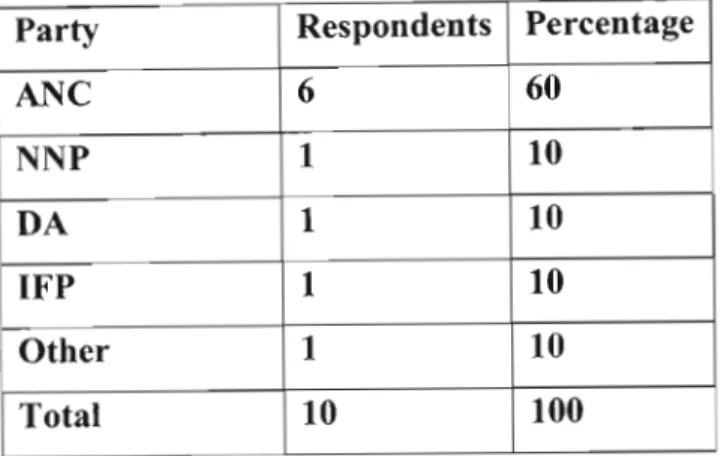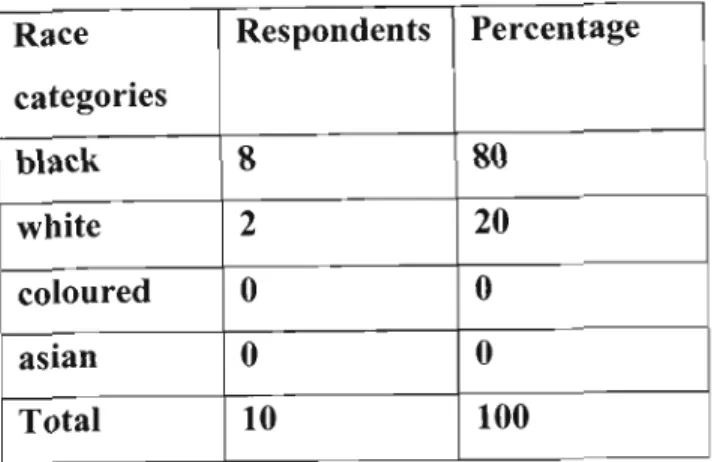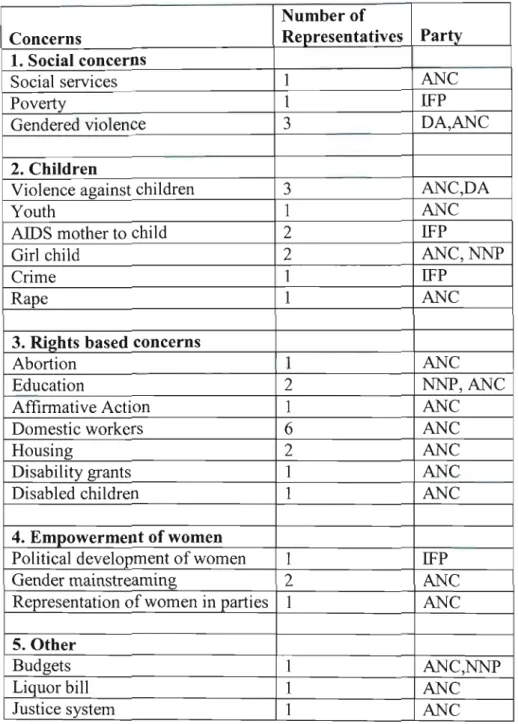In this study I examine the substantive representation of women in the Provincial Legislature of Gauteng. I will examine whether women representatives believe they are making an impact on the lives of women.
Political Context
Members of the provincial legislature are responsible for adopting policies and laws that derive from the executive power, and for creating or initiating policies and laws that are in line with the interests of the population. 12. The members of the provincial executive council are mostly from the ranks of the government party.
Chapter Outline
In chapter three, I examine whether women parliamentarians find their presence in parliament to be effective and whether examples of their success can prove this. In the field of education, it is recommended that training modules be tailored to the specific needs of the individual.
Political Context
The increase in the number of seats held by women was as a direct consequence of women in the ANC negotiating with their party leadership, culminating in Today, South Africa ranks tenth in the world in terms of the number of women in the national parliament.
Key Concepts of this Study
The successive increase in the number of women MPs forms a basis for the remarkable feminization of the government.68. It is difficult to determine at what stage a large number of women in public office will enable women to substantially represent women.86.
Themes of this Study
Another topic explored in this dissertation is that of identifying women's needs and concerns. The next topic that will be explained is the effect of the presence of women in parliament. Although the quota system has contributed to increasing the number of women in parliament, it has not necessarily given women more power.
According to Karram, the extent of women's influence will greatly depend on the number of women in parliament who are motivated to represent women's concerns.
Research Methodology
This study examines the impact of the quota system on enabling women's action. As can be seen from the table and graph, the majority of women in this sample are ANC MPLs. The dominance of the ANC-MPLs in the sample is due to the ANC being the majority party in the Gauteng provincial legislature.
This racially skewed pattern can be explained by the fact that in Gauteng province, the ANC is the dominant party with a large following in black communities, as opposed to communities where other groups are in the majority.

Limitations
I examine, through interview data, the ways in which these women conceptualize action for women as opposed to action for citizens or voters. I further explore the concerns they seek to impact and the ways in which they seek to perform their role. In addition, the perceptions of women parliamentarians in terms of how they articulate concerns differently from male parliamentarians are explored.
Parliamentary women's conceptualizations of representation
For example, respondent 8 from the ANC explains that she acquired satellite offices for her constituency Katlehong to assist the local population more effectively. Mayo defines representation as "acting for" or in the interests of the represented in the manner that responds to it.139 This concept would be extremely difficult to apply to the experience of the aforementioned LPW. Pitkins' (1967) definition of substantive representation as acting in the interest of the represented in a manner that responds to it, would clearly not apply to the experience of the ANC MP who was allocated the Bryanston constituency.
Two respondents, 6 and 8 from the ANC, claimed that COSATU assigned them to the legislature in 1994 because they investigated the concerns of women in the COSATU labor movement.
How do they Represent their Constituency?
The Women's Parliamentary Caucus (WPC)
The convener of the caucus had to determine the agenda of meetings in consultation with members. According to the researcher, the Speaker of the House was prominent III determining the functions of the WPC. It consisted of the Chief Whip, the Chairman of Chairs (in charge of the functioning of all standing committees), the Speaker, the 53.
The chairman sets the legislative agenda in consultation with the whips of the political parties.
The Achievements of the WPC
However, during further interviews it was evident that most of the respondents were divided in opinion about the status of the parliamentary group. Also, the contradictions in the comments made by the MPLs about the fact that the WPC is a committee show the lack of knowledge that the MPLs have about the status of the caucus. It is clear that there is no consistency in MPLs' views on the status of the parliamentary group.
Perhaps the divergence of opinion on the status of the WPC points to a more serious problem, namely the institutional position of the parliamentary group.
The Effectiveness of Women in Parliament
On the other hand, respondents 2 and 3 of the ANC claim that women's presence is still not efficient enough. The proposal by MPW 4 of the NNP above underestimates the potential of women MPWs to develop in this way. However, the influence of the ANC appears to be a major mechanism that ensures that women's concerns are brought to the fore.
She alleged that when it comes to the management of the party, women are not part of it.
Women's Perceptions of their Male colleagues and their Attitudes to Gender Concerns
Increasing the number of women in parliament helps put these concerns on the agenda. Differences in racial and cultural conceptions by women clearly hinder the ability of MPL women to act in unison. The sexual advances made towards women suggested that men were secure in their positions but were prepared to sabotage the position of MPL women.
In this chapter I examine these challenges faced by women MPLs and offer a number of recommendations which, if implemented, would significantly increase the opportunity for women to act for women.
The Impact of the Party-List system of Proportional Representation and the Party List Quota system
The influence of the system of proportional representation of party lists and the system of party list quotas. Although the quota system provided for the inclusion of more women in the political arena, it also created burdens for women MPLs. A statutory quota would be effective in ensuring that women remain in government and are more willing to start creating the parliamentary agenda, knowing that they cannot simply be replaced by a man if they advocate for greater change for women.
In this way, female MPLs' attempts to act for women could be seen as directly representing their constituents rather than undermining the party.
Inadequate Training of Women MPLs
Given the challenges women face in creating the political agenda, I suggest that a legislated quota system should be established in parliament. Women must be taught how to answer questions and this can only be done after they have a thorough understanding of the functions of the legislature. Therefore, first of all, a program should be implemented that guides women on the competencies and functions of various institutional positions and mechanisms.
Training should be provided in policy development, analytical skills, planning, policy analysis, monitoring and supervision.
The Institutional Position of the Women's Parliamentary Caucus
As parliamentary terrain is new to some, communication training designed specifically to teach women how to assert themselves and conduct debates on any platform or forum should be offered. The goal of the training should be to empower women for the positions they will occupy and further prepare them for the world of politics and debate. Furthermore, women MPLs would potentially take the WPC more seriously as they would not be at the mercy of party bosses.
The enhanced institutional status of the WPC will protect women by providing a forum that they will have to attend, and through which they can engage in more critical actions for women.
Racial and Cultural Conceptions of Representation
This clearly shows that women across racial and cultural divisions did not understand each other. Better communication channels need to be established in the WPC so that women can learn more about each other's cultural limitations and how they impact the ability of women to represent. Through a better understanding of each other, women will be better placed to find ways in which they can act in harmony.
Through a better understanding of each other, women will then be better able to defend and support each other in the legislature.
Male Domination of the Institutional Arena
The previously discussed inconsistency of responses around committee meeting times, for example, implies that women who fear being labeled do not act in unison. Male MPLs dominate decisions and female MPLs are silenced through a culture that does not support women speaking out. Substantive representation assumes that women parliamentarians share an affinity with women in society and are therefore able to represent multiple gendered interests.
Fourth, I examined the challenges women parliamentarians experienced in carrying out their representative role and I made a series of recommendations designed to improve their opportunities for the substantive representation of women.
Women's Conceptualization of political representation
Third, I considered whether women parliamentarians perceived their presence to be effective in influencing the policy agenda.
Methods used by women in their representation role
Although some MPL MPs believed that the group had been successful in achieving changes in legislation, many were not entirely clear about the status of the group, as some considered the group to be a committee. Women MPLs do not seem to be brave in asserting their demands for a change in caucus status. Some MPLs have suggested that assemblies are not something that can be taken seriously, so if that is the case, then I would argue that women alone are not powerful enough to effect a change in group status.
It was also mentioned that there are no clearly defined benchmarks for women in the caucus to work against, along with a lack of coordination.
Challenges Experienced by Women in Carrying out their Representation role
Female MPs viewed their male counterparts as disrespecting the presence of women in parliament. The failure of women to act in unison was seen as problematic in their efforts to represent the concerns of women. They also feared that raising concerns about women would lead to them being labeled and their careers would suffer.
Women in Parliamentary Politics: The Gender Agenda and Political Representation, in consideration for The Journal of Legislative Studies.

